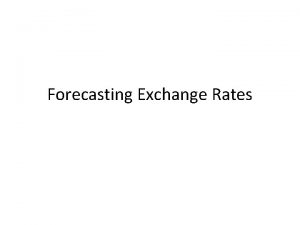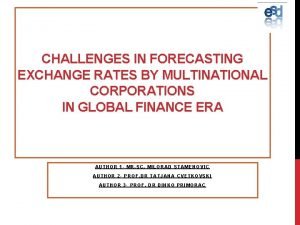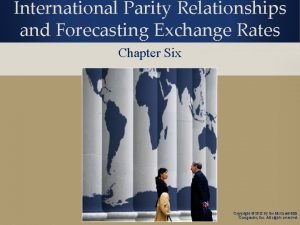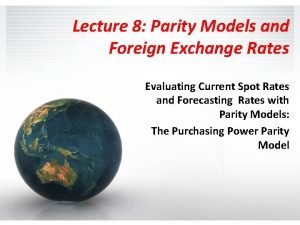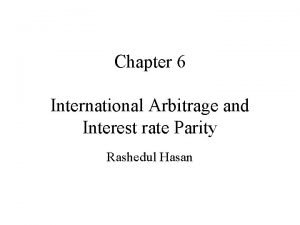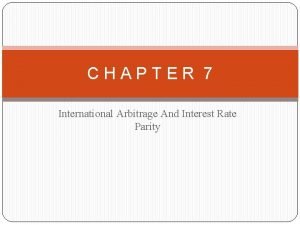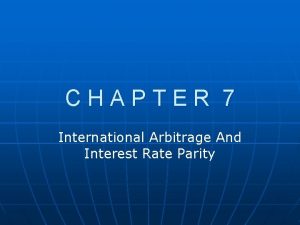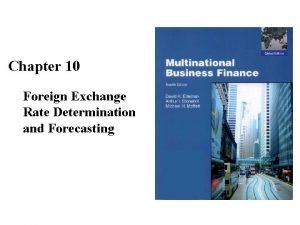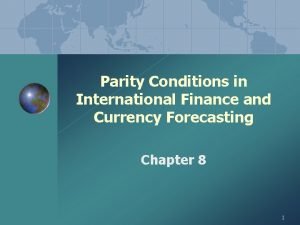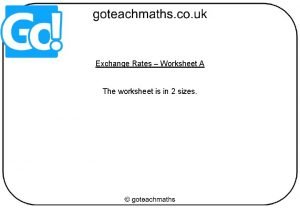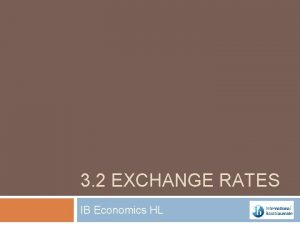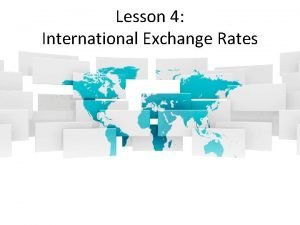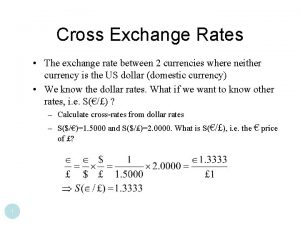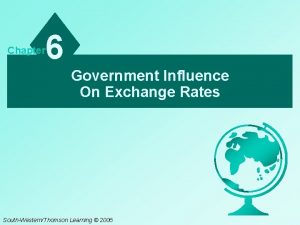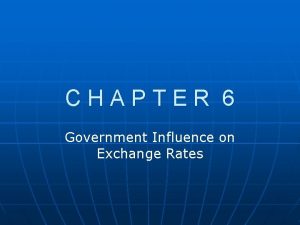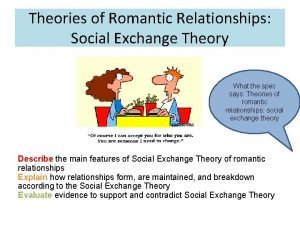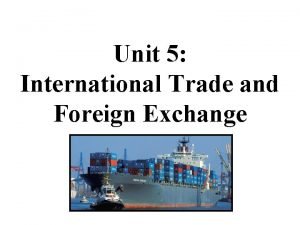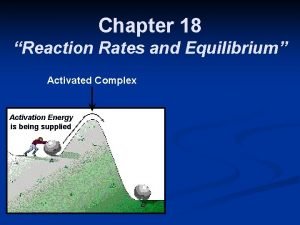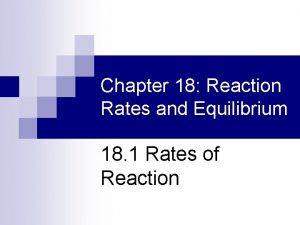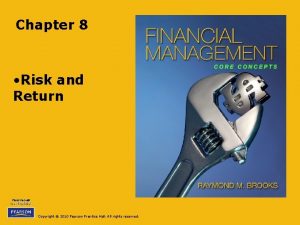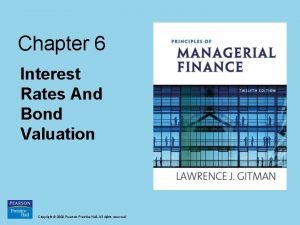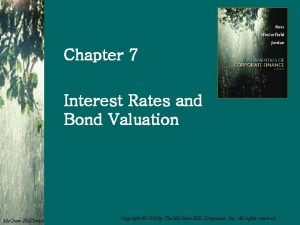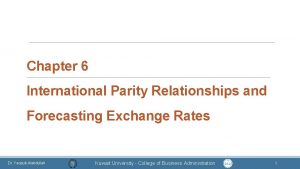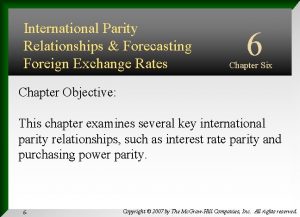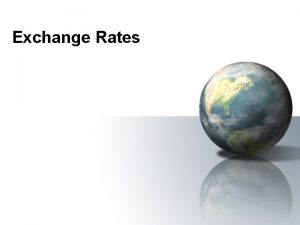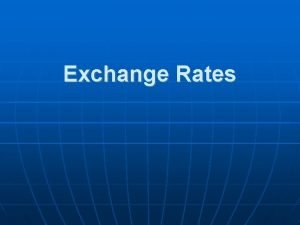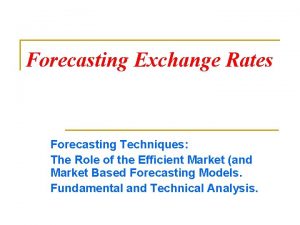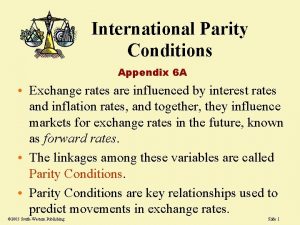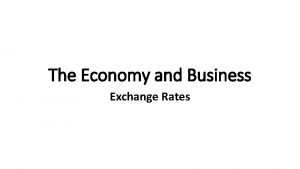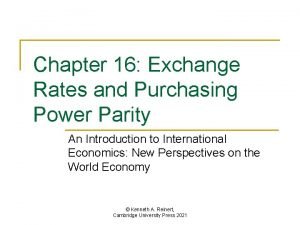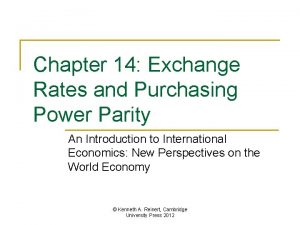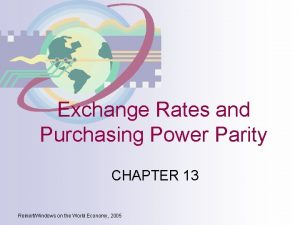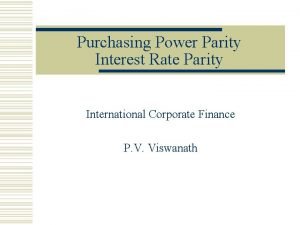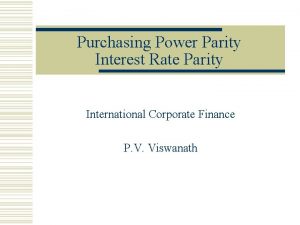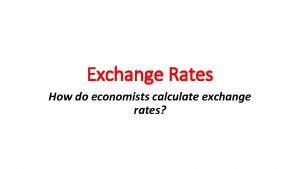International Parity Relationships and Forecasting Exchange Rates Chapter








































- Slides: 40

International Parity Relationships and Forecasting Exchange Rates Chapter Six Copyright © 2012 by the Mc. Graw-Hill Companies, Inc. All rights reserved.

Chapter Outline § Interest Rate Parity – – Covered Interest Arbitrage IRP and Exchange Rate Determination Currency Carry Trade Reasons for Deviations from IRP § Purchasing Power Parity – PPP Deviations and the Real Exchange Rate – Evidence on Purchasing Power Parity § The Fisher Effects § Forecasting Exchange Rates – – Efficient Market Approach Fundamental Approach Technical Approach Performance of the Forecasters 6 -2

Interest Rate Parity Defined § IRP is a “no arbitrage” condition. § If IRP did not hold, then it would be possible for an astute trader to make unlimited amounts of money by exploiting the arbitrage opportunity. § Since we don’t typically observe persistent arbitrage conditions, we can safely assume that IRP holds. …almost all of the time! 6 -3

Interest Rate Parity Carefully Defined Consider alternative one-year investments for $100, 000: 1. Invest in the U. S. at i$. Future value = $100, 000 × (1 + i$). 2. Trade your $ for £ at the spot rate and invest $100, 000/S$/£ in Britain at i£ while eliminating any exchange rate risk by selling the future value of the F$/£ British investment forward. Future value = $100, 000(1 + i )× £ S$/£ Since these investments have the same risk, they must have the same future value (otherwise an arbitrage would exist). F$/£ (1 + i£) × = (1 +F i$) = S × (1 + i$) S$/£ $/£ (1 + i£) 6 -4

$1, 000 S$/£ Alternative 2: Send your $ on a round trip to Britain IRP Step 2: Invest those pounds at i£ Future Value = $1, 000 IRP Alternative 1: Invest $1, 000 at i$ $1, 000×(1 + i$) = Step 3: Repatriate future value to the U. S. A. $1, 000 S$/£ (1+ i£) × F$/£ Since both of these investments have the same risk, they must have the same future value—otherwise an arbitrage would exist. 6 -5

Interest Rate Parity Defined § The scale of the project is unimportant. $1, 000 (1+ i ) × F $1, 000×(1 + i$) = £ $/£ S$/£ F$/£ × (1+ i£) (1 + i$) = S$/£ § IRP is sometimes approximated as: i$ – i£ ≈ F – S S 6 -6

Interest Rate Parity Carefully Defined § No matter how you quote the exchange rate ($ per ¥ or ¥ per $) to find a forward rate, increase the dollars by the dollar rate and the foreign currency by the foreign currency rate: 1 + i¥ F¥/$ = S¥/$ × 1 + i$ or 1 + i$ F$/¥ = S$/¥ × 1 + i ¥ …be careful—it’s easy to get this wrong. 6 -7

IRP and Covered Interest Arbitrage § If IRP failed to hold, an arbitrage would exist. It’s easiest to see this in the form of an example. § Consider the following set of foreign and domestic interest rates and spot and forward exchange rates. Spot exchange rate 360 -day forward rate S($/£) = $2. 0000/£ F 360($/£) = $2. 0100/£ U. S. discount rate i$ = 3. 00% British discount rate i£ = 2. 49% 6 -8

IRP and Covered Interest Arbitrage § A trader with $1, 000 could invest in the U. S. at 3. 00%. In one year his investment will be worth: $1, 030 = $1, 000 (1+ i$) = $1, 000 (1. 03) § Alternatively, this trader could: 1. Exchange $1, 000 for £ 500 at the prevailing spot rate. 2. Invest £ 500 for one year at i£ = 2. 49%; earn £ 512. 45. 3. Translate £ 512. 45 back into dollars at the forward rate F 360($/£) = $2. 01/£. The £ 512. 45 will be worth $1, 030. 6 -9

Other Choice: Buy £ 500 at $2/£. £ 1 £ 500 = $1, 000× $2. 00 $1, 000 One Choice: Invest $1, 000 at 3%. FV = $1, 030 Arbitrage I £ 500 Step 2: Invest £ 500 at i£ = 2. 49%. £ 512. 45 In one year £ 500 will be worth Step 3: Repatriate £ 512. 45 = to the U. S. at £ 500 (1+ i£) F 360($/£) = $2. 01/£ $1, 030 F£(360) $1, 030 = £ 512. 45 × £ 1 6 -10

IRP& Exchange Rate Determination § According to IRP only one 360 -day forward rate F 360($/£) can exist. It must be the case that F 360($/£) = $2. 01/£ § Why? § If F 360($/£) $2. 01/£, an astute trader could make money with one of the following strategies. 6 -11

Arbitrage Strategy I § If F 360($/£) > $2. 01/£: 1. Borrow $1, 000 at t = 0 at i$ = 3%. 2. Exchange $1, 000 for £ 500 at the prevailing spot rate (note that £ 500 = $1, 000 ÷ $2/£. ); invest £ 500 at 2. 49% (i£) for one year to achieve £ 512. 45. 3. Translate £ 512. 45 back into dollars; if F 360($/£) > $2. 01/£, then £ 512. 45 will be more than enough to repay your debt of $1, 030. 6 -12

Step 2: Buy pounds £ 1 £ 500 = $1, 000× $2. 00 $1, 000 £ 500 Arbitrage I Step 3: Invest £ 500 at i£ = 2. 49%. £ 512. 45 In one year £ 500 will be worth £ 512. 45 = £ 500 (1+ i£) Step 4: Repatriate to the U. S. Step 1: Borrow $1, 000. More F£(360) $1, 030 < £ 512. 45 × Step 5: Repay than $1, 030 £ 1 your dollar loan with $1, 030. If F£(360) > $2. 01/£, £ 512. 45 will be more than enough to repay your dollar obligation of $1, 030. The excess is your profit. 6 -13

Arbitrage Strategy II § If F 360($/£) < $2. 01/£: 1. Borrow £ 500 at t = 0 at i£= 2. 49%. 2. Exchange £ 500 for $1, 000 at the prevailing spot rate; invest $1, 000 at 3% for one year to achieve $1, 030. 3. Translate $1, 030 back into pounds; if F 360($/£) < $2. 01/£, then $1, 030 will be more than enough to repay your debt of £ 512. 45. 6 -14

Step 2: Buy dollars $2. 00 $1, 000 = £ 500× £ 1 $1, 000 £ 500 Arbitrage II Step 1: Borrow £ 500. Step 5: Repay More Step 3: your pound loan than Invest $1, 000 with £ 512. 45 at i$ = 3%. Step 4: Repatriate to the U. K. In one year $1, 000 F£(360) will be worth $1, 030 > £ 512. 45 × $1, 030 £ 1 If F£(360) < $2. 01/£, $1, 030 will be more than enough to repay your dollar obligation of £ 512. 45. Keep the rest as profit. 6 -15

Currency Carry Trade § Currency carry trade involves buying a currency that has a high rate of interest and funding the purchase by borrowing in a currency with low rates of interest, without any hedging. § The carry trade is profitable as long as the interest rate differential is greater than the appreciation of the funding currency against the investment currency. 6 -16

Currency Carry Trade Example Suppose the 1 -year borrowing rate in dollars is 1%. The 1 -year lending rate in pounds is 2½%. The direct spot ask exchange rate is $1. 60/£. A trader who borrows $1 m will owe $1, 010, 000 in one year. Trading $1 m for pounds today at the spot generates £ 625, 000 invested for one year at 2½% yields £ 640, 625. The currency carry trade will be profitable if the spot bid rate prevailing in one year is high enough that his £ 640, 625 will sell for at least $1, 010, 000 (enough to repay his debt). § No less expensive than: § § § § $1, 010, 000 S 360($/£) = £ 640, 625 b = $1. 5766 £ 1. 00 6 -17

Reasons for Deviations from IRP § Transactions Costs – The interest rate available to an arbitrageur for borrowing, ib, may exceed the rate he can lend at, il. – There may be bid-ask spreads to overcome, Fb/Sa < F/S. – Thus, (Fb/Sa)(1 + i¥l) (1 + i¥ b) 0. § Capital Controls – Governments sometimes restrict import and export of money through taxes or outright bans. 6 -18

Transactions Costs Example § Will an arbitrageur facing the following prices be able to make money? Borrowing Lending $ 5. 0% 4. 50% € 5. 5% 5. 0% Spot F($/ €) = S($/ €) × Bid $1. 42 = € 1. 00 (1 + i$) (1 + i€) Ask $1. 45 = € 1, 00 Forward $1. 415 = € 1. 00 $1. 445 = € 1. 00 F 1 b($/€) = a b S (1+i ($/€) $) 0 (1+i€l ) F 1 a($/€) = b l S (1+i ($/€) $) 0 (1+i€b) 6 -19

$1 m 0 Borrow $1 m at i$b Step 1 $1 m×(1+ib$) IRP 1 Step 2 1 $1 m × a ×(1+il€)×Fb 1($/€) = $1 m×(1+ib$) Buy € at S 0($/€) spot ask No arbitrage forward bid price (for customer): b b a (1+i ) S (1+i ($/€) $ 0 $) Step 4 b F 1($/€) = = 1 l l Sell € at ×(1+i ) € € S 0 a($/€) forward bid = $1. 4431/€ 1 1 l Step 3 invest € at i€ $1 m × a ×(1+il€) $1 m × a S 0($/€) 6 -20 (All transactions at retail prices. )

b € 1 m × S 0($/€) 0 € 1 m × Sb 0($/€) × (1+il$) l lend at i$ Step 3: IRP 1 € 1 m × Sb 0($/€) × (1+il$) ÷ F 1 a($/€) = € 1 m×(1+ib€) No arbitrage forward ask price: Step 2: sell € 1 m at spot bid € 1 m F 1 a($/€) = l b S 0 (1+i ($/€) $) (1+i€b) = $1. 4065/€ Step 1: borrow € 1 m at i€b Step 4 buy € at forward ask € 1 m×(1+i€b) (All transactions at retail prices. ) 6 -21

Why This May Seem Confusing § On the last two slides we found “no arbitrage. ” – Forward bid prices of $1. 4431/€. – Forward ask prices of $1. 4065/€. § Normally the dealer sets the ask price above the bid —recall that this difference is his expected profit. § But the prices on the last two slides are the prices of indifference for the customer, NOT the dealer. – At these forward bid and ask prices the customer is indifferent between a forward market hedge and a money market hedge. 6 -22

Setting Dealer Forward Bid and Ask § Dealer stands ready to be on the opposite side of every trade. – Dealer buys foreign currency at the bid price. – Dealer sells foreign currency at the ask price. – Dealer borrows (from customer) at the lending rates. – Dealer lends to his customer at the posted borrowing rates. il$ = 4. 5% and i€l = 5. 0% Borrowing Lending $ 5. 0% 4. 50% € 5. 5% 5. 0% i$b = 5. 0%, ib€ = 5. 5%. Spot Bid $1. 42 = € 1. 00 Ask $1. 45 = € 1. 00 Forward $1. 415 = € 1. 00 $1. 445 = € 1. 00 6 -23

Setting Dealer Forward Bid Price Our dealer is indifferent between buying euros today at the spot bid price and buying euros in 1 year at the forward bid price. $1 m × $1 m×(1+ib$) Invest at i$b He is willing to spend He is also willing to buy at $1 m today and receive b 1 $1 m × b S 0($/€) 1 S 0 b($/€) Invest at i€b F 1 b($/€) = b S 0 (1+i ($/€) $) (1+i€b) forward bid spot bid $1 m 1 b $1 m × b ×(1+i€) 6 -24 S 0($/€)

Setting Dealer Forward Ask Price Our dealer is indifferent between selling euros today at the spot ask price and selling euros in 1 year at the forward ask price. € 1 m Invest at i$b € 1 m × S 0 b($/€) ×(1+ib$) He is willing to spend He is also willing to buy at € 1 m today and receive b € 1 m × S 0 b($/€) Invest at i€b Fa 1($/€) = a S 0 (1+i ($/€) $) (1+i€b) forward ask spot ask € 1 m × S 0 b($/€) € 1 m×(1+ib€) 6 -25

PPP and Exchange Rate Determination § The exchange rate between two currencies should equal the ratio of the countries’ price levels: P$ S($/£) = P£ For example, if an ounce of gold costs $300 in the U. S. and £ 150 in the U. K. , then the price of one pound in terms of dollars should be: S($/£) = P$ = $300 = $2/£ P£ £ 150 Suppose the spot exchange rate is $1. 25 = € 1. 00. If the inflation rate in the U. S. is expected to be 3% in the next year and 5% in the euro zone, then the expected exchange rate in one year should be $1. 25×(1. 03) = € 1. 00×(1. 05). 6 -26

PPP and Exchange Rate Determination § The euro will trade at a 1. 90% discount in the forward market: F($/€) = S($/€) $1. 25×(1. 03) € 1. 00×(1. 05) $1. 25 € 1. 00 1. 03 1 + $ = = 1. 05 1 + € Relative PPP states that the rate of change in the exchange rate is equal to differences in the rates of inflation—roughly 2%. 6 -27

PPP and IRP § Notice that our two big equations equal each other: PPP F($/€) 1 + $ = 1 + € S($/€) IRP = 1 + i$ F($/€) = 1 + i€ S($/€) 6 -28

Expected Rate of Change in Exchange Rate as Inflation Differential § We could also reformulate our equations as inflation or interest rate differentials: F($/€) 1 + $ = S($/€) 1 + € F($/€) – S($/€) 1 + $ 1 + € = – 1 = – S($/€) 1 + € F($/€) – S($/€) $ – € E(e) = ≈ $ – € = S($/€) 1 + € 6 -29

Expected Rate of Change in Exchange Rate as Interest Rate Differential F($/€) – S($/€) i$ – i€ = E(e) = S($/€) 1 + i€ ≈ i$ – i€ § Given the difficulty in measuring expected inflation, managers often use a “quick and dirty” shortcut: $ – € ≈ i$ – i€ 6 -30

Evidence on PPP § PPP probably doesn’t hold precisely in the real world for a variety of reasons. – Haircuts cost 10 times as much in the developed world as in the developing world. – Film, on the other hand, is a highly standardized commodity that is actively traded across borders. – Shipping costs, as well as tariffs and quotas, can lead to deviations from PPP. § PPP-determined exchange rates still provide a valuable benchmark. 6 -31

Approximate Equilibrium Exchange Rate Relationships E(e) ≈ IFE (i$ – i¥) ≈ FEP ≈ PPP F – S ≈ IRP S ≈ FE ≈ FRPPP E( $ – £) 6 -32

The Exact Fisher Effects § An increase (decrease) in the expected rate of inflation will cause a proportionate increase (decrease) in the interest rate in the country. § For the U. S. , the Fisher effect is written as: 1 + i$ = (1 + $ ) × E(1 + $) Where: $ is the equilibrium expected “real” U. S. interest rate. E( $) is the expected rate of U. S. inflation. i$ is the equilibrium expected nominal U. S. interest rate. 6 -33

International Fisher Effect If the Fisher effect holds in the U. S. , 1 + i$ = (1 + $ ) × E(1 + $) and the Fisher effect holds in Japan, 1 + i¥ = (1 + ¥ ) × E(1 + ¥) and if the real rates are the same in each country, $ = ¥ then we get the International Fisher Effect: E(1 + ¥) 1 + i¥ = 1 + i$ E(1 + $) 6 -34

International Fisher Effect If the International Fisher Effect holds, E(1 + ¥) 1 + i¥ = 1 + i$ E(1 + $) and if IRP also holds, 1 + i¥ F¥/$ = 1 + i$ S¥/$ then forward rate PPP holds: F¥/$ E(1 + ¥) = S¥/$ E(1 + $) 6 -35

Exact Equilibrium Exchange Rate Relationships FEP IFE 1 + i¥ 1 + i$ PPP IRP FE FRPPP E(1 + ¥) E(1 + $) 6 -36

Forecasting Exchange Rates: Efficient Markets Approach § Financial markets are efficient if prices reflect all available and relevant information. § If this is true, exchange rates will only change when new information arrives, thus: St = E[St+1] and Ft = E[St+1| It] § Predicting exchange rates using the efficient markets approach is affordable and is hard to beat. 6 -37

Forecasting Exchange Rates: Fundamental Approach § Involves econometrics to develop models that use a variety of explanatory variables. This involves three steps: – Step 1: Estimate the structural model. – Step 2: Estimate future parameter values. – Step 3: Use the model to develop forecasts. § The downside is that fundamental models do not work any better than the forward rate model or the random walk model. 6 -38

Forecasting Exchange Rates: Technical Approach § Technical analysis looks for patterns in the past behavior of exchange rates. § Clearly it is based upon the premise that history repeats itself. § Thus, it is at odds with the EMH. 6 -39

Performance of the Forecasters § Forecasting is difficult, especially with regard to the future. § As a whole, forecasters cannot do a better job of forecasting future exchange rates than the forecast implied by the forward rate. § The founder of Forbes Magazine once said, “You can make more money selling financial advice than following it. ” 6 -40
 Fundamental forecasting of exchange rates
Fundamental forecasting of exchange rates Challenges in forecasting exchange rates
Challenges in forecasting exchange rates Materi peramalan nilai tukar
Materi peramalan nilai tukar Exchange rate forecasting techniques
Exchange rate forecasting techniques International parity relationships
International parity relationships A rate is a ratio
A rate is a ratio Ratios guided notes
Ratios guided notes Ratios rates and unit rates
Ratios rates and unit rates Ratios rates and unit rates
Ratios rates and unit rates Purchasing power parity theory
Purchasing power parity theory Locational arbitrage example
Locational arbitrage example Interest rate parity example
Interest rate parity example Locational arbitrage
Locational arbitrage Exchange rate determination and forecasting
Exchange rate determination and forecasting International parity condition
International parity condition Exchange rate maths literacy grade 12
Exchange rate maths literacy grade 12 Heathrow exchange rates
Heathrow exchange rates Overvalued currency
Overvalued currency Exchange rates lesson
Exchange rates lesson Cross exchange rate formula
Cross exchange rate formula Government influence on exchange rates
Government influence on exchange rates Graphing exchange rates
Graphing exchange rates Government intervention in exchange rates
Government intervention in exchange rates Thibaut and kelley social exchange theory
Thibaut and kelley social exchange theory Exchange relationships
Exchange relationships Addison currency exchange
Addison currency exchange Voluntary exchange
Voluntary exchange Gas exchange key events in gas exchange
Gas exchange key events in gas exchange Difference between balance of trade and balance of payment
Difference between balance of trade and balance of payment Types of exchange rate
Types of exchange rate Reaction rates and equilibrium worksheet answers chapter 19
Reaction rates and equilibrium worksheet answers chapter 19 Chapter 7 interest rates and bond valuation
Chapter 7 interest rates and bond valuation Chapter 18 reaction rates and equilibrium answer key
Chapter 18 reaction rates and equilibrium answer key Chapter 18 reaction rates and equilibrium
Chapter 18 reaction rates and equilibrium Chapter 8 risk and rates of return problem solutions
Chapter 8 risk and rates of return problem solutions Your uncle would like to restrict his interest rate risk
Your uncle would like to restrict his interest rate risk Chapter 6 interest rates and bond valuation
Chapter 6 interest rates and bond valuation Chapter 7 interest rates and bond valuation
Chapter 7 interest rates and bond valuation Chapter 6 interest rates and bond valuation
Chapter 6 interest rates and bond valuation Wise foreign exchange program
Wise foreign exchange program Xlri student exchange
Xlri student exchange
